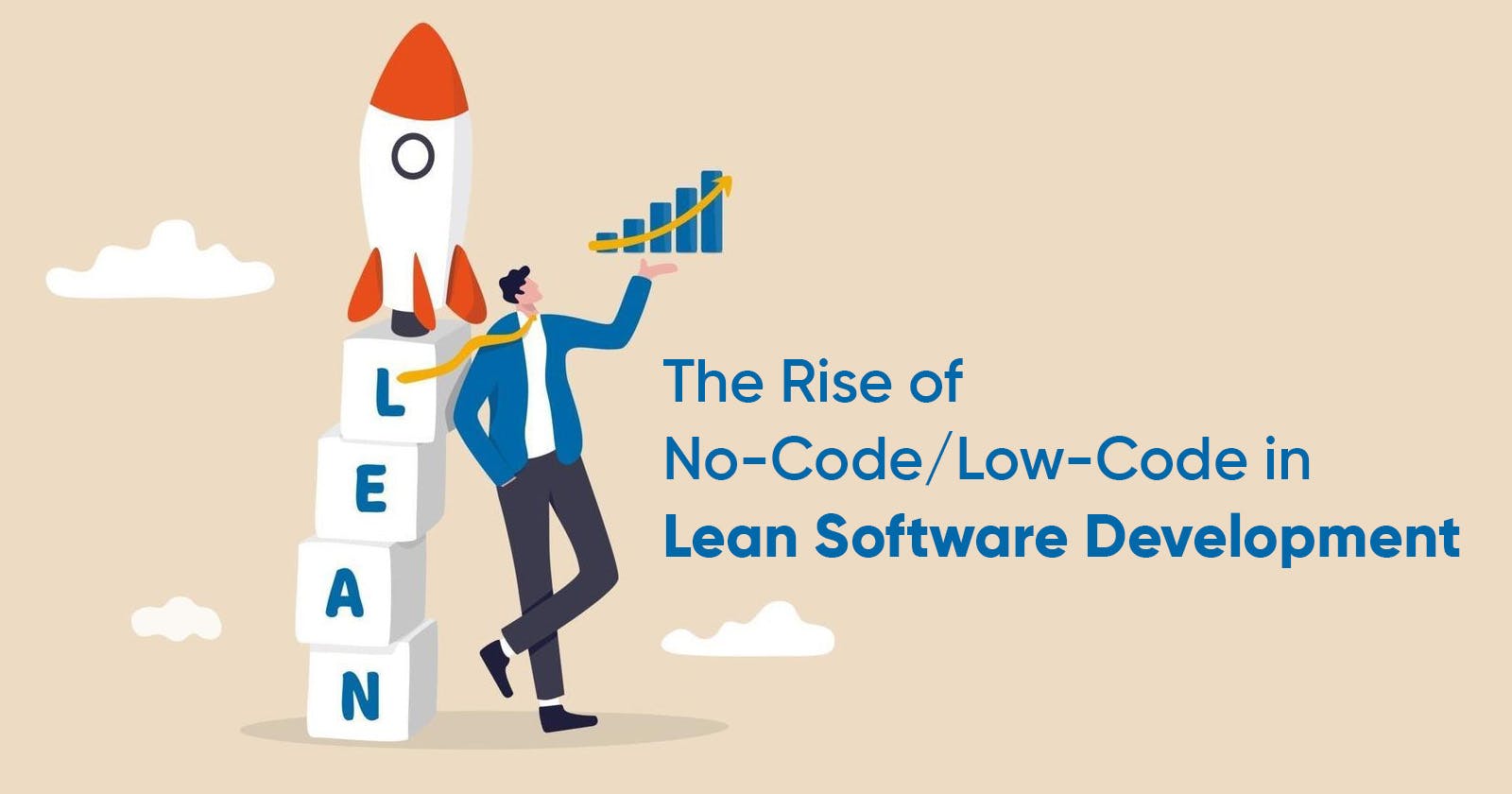In today's dynamic landscape of technology and software development, efficiency and agility have become the two cornerstones of success. Lean software development is increasingly emerging in response to a market dynamic wherein, with a competitive environment, businesses are seeking to get ahead of one another. At the heart of this paradigm shift is the meteoric rise of No-Code/Low-Code (LCNC) platforms, promising to flip the paradigm through which software is written, deployed, and managed on its head. This blog takes a deep dive into the LCNC platform growth within the lean software development ecosystem, considering the transformational potential, the compelling data, and the market trends.
Understanding Lean Software Development and LCNC Synergy
Lean Software Development, which is embedded in lowering waste and increasing the efficiency of resources, is the optimum complement to inherent abilities on LCNC platforms. Some of these platforms are not tools; some are even a medium that enables innovation in developers and non-developers to develop applications faster and with fewer "bloat" or "stuff" to be in the way of the user's needs. The Lean principles and the LCNC technology converge in a common goal of providing as much value as possible to the customer with processes that enable the same to be offered in a streamlined manner.
The Efficiency Revolution
The most striking of LCNC platforms is the ability to enhance development efficiency dramatically. Some studies suggested a possible 90% reduction in development and deployment time; businesses have all the more reason to react to market change with speed never seen before. This efficiency, among others, translates not only to reduced time-to-market but huge economic benefits. For instance, companies that use LCNC to develop customer-facing applications have 58% more revenue reported. Further, the profound effect these platforms create is that solutions are built 56% faster than traditional development methodologies simply by suggesting their power to revolutionize software development, albeit within a lean framework.
Market Growth and Adoption: A Perspective

The LCNC market is experiencing explosive growth, with projections indicating its vast potential. Forrester's forecasts are even more optimistic—their assessment is $45.5 billion by 2025. Growth is projected to inch higher, especially in adoption rates, which suggest that low-code methods will be employed in 65% of app development activities by 2024. This growth is not merely theoretical; it reflects a paradigm shift in how software is developed, deployed, and utilized across industries.
Three out of four leading world organizations have already adopted these LCNC platforms or are going to use at least four low code development tools in their projects. This tendency is a real showing of what these platforms can bring to the users and what role they will be playing for enabling businesses to innovate more freely and, at the same time, efficiently. The 31% Compound Annual Growth Rate (CAGR) certainly points toward this sector being a growing one, estimated to reach a whopping $187 billion in global revenue by the year 2030. It has been predicted that LCNC technologies will constitute 70% of new business applications by the year 2025, hence really being key to future software development.
LCNC Platforms: A Catalyst for Lean Innovation
Bringing together the LCNC platforms to practice Lean Software Development and innovative, efficient, customer-centric design. The platforms propose a different value proposition in rapidly prototyping, iterating, and deploying applications that best satisfy customer needs, today, given the tools and technology. This ability is very valuable in an environment of lean, mainly focusing on the value delivered through continuous improvement and adapting very rapidly to feedback from changing market demands.
Practical Applications in the Lean Landscape
The LCNC platforms are an actual marvel of practical uses across industries and types of projects. Some of these that highlight include:
Rapid prototyping: It means that under the lean environment, ideas for prototyping and even its stakeholders' validation can be done at a very fast pace. The LCNC platform equips teams with the possibility of turning an idea into a prototype within days, since the development always matches user needs and business goals.
Business Process Automation: An LCNC tool that many organizations have used to automate some of the most arduous of their business operations, from customer service workflows to internal operational sequences, by reducing manual effort and improving efficiency.
Customer-Facing Applications: The foregoing massive increase in revenues related to LCNC platforms is usually ignited by customer-facing applications. It allows companies to quickly create, deploy, and manage web and mobile applications to improve customers' experience, engagement, and retention.
These applications illustrate how LCNC platforms accelerate the build-measure-learn lean cycle, letting companies innovate faster than ever before more responsively.
Challenges in Lean Software development

Despite their advantages, integrating LCNC platforms into lean software development is not without challenges. Key among these are:
Complexity and Scalability Issues: As projects scale, the limitations of LCNC platforms in handling complex functionalities can become apparent. Organizations must balance the ease of use of LCNC tools with the need for custom development to support advanced features or large-scale deployments.
Skills and Mindset Shift: Adopting LCNC platforms requires a shift in mindset for traditional developers accustomed to coding from scratch. There is also a learning curve associated with mastering these platforms, although significantly less steep than traditional development technologies.
Governance and Security Concerns: The greatest necessity of all is to ensure governance, compliance, and the standards of security in the best of interests coming with democratization, meaning development capabilities will expand toward a much broader talent pool. This requires that organizations develop clear policies and oversight mechanisms to avoid risk.
These, therefore, call for a strategic effort that would combine the strength of LCNC platforms with traditional development practices, as necessary, and at the same time nurture a culture of learning and adaptation.
Looking Ahead: The Future of Lean Software Development with LCNC
The future of lean software development, powered by LCNC platforms, is promising but will require adaptation and evolution. Some of the trends and predictions when looking into the future:
Democratization of Development: The LCNC platforms that are emerging today will bring about further democratization of software development, encouraging more numbers of individuals and teams to build solutions without deep technical expertise. This democratization would create an innovation curve explosion, as now many more people would be participating in building those technology solutions.
Hybrid Development Approaches: To weigh in the weaknesses and strengths of both LCNC and traditional development, it would likely come out to be a reality of the increased hybrid approach. In such approaches, they would gain the speed and efficiency of LCNC in parts of the development process while retaining traditional coding for areas that require much customization or complex logic.
Enhanced Integration Capabilities: Overcoming the challenge of scalability and complexity, the LCNC platform is most likely to grow in a manner that can offer more, better, and enhanced integration capabilities. This will allow such platforms to work as the glue between different systems and technologies for more complex and scalable solutions.
Focus on Governance and Security: As LCNC platforms are commonly used, it will increase governance, security, and compliance. Tools and frameworks shall be developed in a way that organizations are facilitated to manage these requirements efficiently, enabling LCNC-driven development to fall in place with broader business and regulatory requirements.
Strategic Implementation for Maximized Benefit

For organizations looking to harness the full potential of LCNC platforms within a lean software development context, strategic implementation is key. This involves a few critical steps:
Needs Assessment and Platform Selection: Begin with a thorough assessment of organizational needs and the specific problems that LCNC solutions can solve. Select platforms that align closely with these needs, considering factors like ease of use, integration capabilities, and scalability.
Education and Training: Equip teams with the knowledge and skills needed to effectively use LCNC platforms. This involves not just technical training but also fostering an understanding of how these tools fit within the broader context of lean development practices.
Iterative Approach and Feedback Loops: Execute LCNC solutions iteratively through the Lean principle of continuous improvement. Quickly develop prototypes of the designed solutions, gather users' feedback on effectiveness, and continue learning to adapt solutions produced.
Bridging the Gap Between Technical and Non-Technical Teams
One of the most powerful features of LCNC is the ability to bridge the technical and non-technical teams. This, therefore, implies that the LCNC platform can be a tool in enhancing collaboration and innovation of teams through the provision of an opportunity for non-traditional coders to make direct software contributions. Gains that accrue are dependent on organizations:
Foster Culture of Collaboration: Encourage transparent communication and working together of technical and non-technical teams, including breaking silos, building cross-functional teams to leverage diversified capabilities, and perspectives of the team.
Define Clear Roles and Responsibilities: However, in so doing, while democratizing development by LCNC platforms, there is a need to define clear roles and responsibilities so that there are well-managed projects having clear lines of decision-making and ownership.
The Evolving Role of Software Developers
LCNC platforms change the rules of the game for software developers: instead of putting them out of business, LCNC platforms mean that developers will move up the value chain to more complex and strategic tasks. More and more, developers become architects of digital solutions in places where a high level of technical understanding is needed. It might be deep knowledge in the areas of system integration, custom feature development, or sophisticated security measures. This shift represents not a change but an elevation of the developer's role, requiring a mix of technical excellence and strategic thinking.
Future Technologies and Integration

In due course, LCNC converged with emerging technologies holds great promise for lean software development. Artificial intelligence (AI), machine learning (ML), and blockchain are some of the ripe technologies; integration with LCNC platforms would further enhance the abilities and areas of their application. AI/ML is the automation of decision processes within applications, while blockchain offers the automation of sorts of security with transparency for a variety of applications managing data.
End notes
Low-code and no-code platforms promise to turn the tide of the software development landscape. Subscribing to the lean software development principles, LCNC platforms are harbingers of a much more effective, participatory, and innovative way of creating software. Such potentiality, brought out to life, requires strategic implementation, focusing on collaboration and the adaptive approach of the evolving developer role.
And so, as we find ourselves moving in this changing landscape, dare we ask how to enable the strengths of LCNC platforms while staying agile in view of the challenges and opportunities that will come our way. And if the view of the future provides any hint, the lean software development powered by the LCNC technologies is even further democratized, efficient, and creative in its approach to address the digital challenges for tomorrow. The future is synonymous with continuous learning, adaptation, and collaboration among all sections of software development stakeholders.

